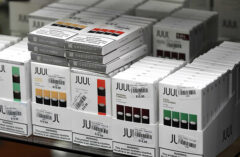Table of Contents
Last Updated on October 27, 2016 by
Vaping Regulations in Europe:
A Big Win for Big Tobacco?
New EU laws could see 90% of e-cigarettes taken off the market, according to Pascal Culverhouse of the Electric Tobacconist
The rise in vaping has coincided with smoking’s largest decline in a decade — but that progress could be stubbed out by controversial new European regulations. From May 2016, a controversial revision of the Tobacco Products Directive will come into place that will “regulate” (read: obliterate) the e-cigarette market in Europe.
You might be wondering why e-cigarettes, a product containing zero tobacco, are being included in the TPD in the first place. The answer, supposedly, is to be found in the “gateway theory.” The EU argues that because vaping products contain nicotine and mimic smoking, they could theoretically be a gateway to tobacco consumption and therefore can be regulated as tobacco products. But the scientific evidence for the gateway theory is practically non-existent: Public Health England found that “very few non-smokers” become vapers and they suggest that the “ill-defined” gateway theory be abandoned.
How will the Tobacco Product Directive affect vaping?
When the TPD comes into place e-cigarettes — which pose no proven health risks and are clearly healthier than tobacco products by any measure — will be regulated more severely than traditional tobacco products. The legislation means that:
- All advertising of e-cigarettes will be banned.
- Nicotine content will be reduced to less than 2%.
- E-juice bottles will be limited to 10 ml and tank size to 2 ml.
- Warnings will be placed on e-cigarettes in a way that is designed to mimic the warning on traditional cigarette packets.
- New products will have to be placed before a commission before coming to the market, and undergo more rigorous testing than cigarettes do.
- E-cigarettes will have to be “leak-free”.
- In some European countries e-cigarettes will be regulated as medicines.
It’s been estimated that 90% of vaping products which are legal today will be banned come May. It’s extremely likely that we will see vapers transition back to smoking if their favourite products are taken off the market.
These regulations run the range from impractical to impossible. For instance, if nicotine is limited to 2%, then e-cigarettes will be much less appealing to current smokers as they are accustomed to a stronger nicotine buzz — effectively alienating those that stand to gain the most from e-cigarettes. Limiting e-juice containers to 10 ml is a headache too. The given reason is the risk of child poisoning, but the answer is surely safety caps. Bleach, oven cleaner and washing detergent all pose a similar risk to children, yet we still buy bleach in two litre bottles. The commission will have the power to demand that new products undergo thousands of hours of testing before they can be sold, which means that only the largest companies (read: big tobacco) will be able to afford to bring a product to market.
None of this is to say that e-cigarettes should be completely unregulated. Proportionate regulation used correctly could theoretically protect consumers from substandard products. The problem is that these regulations don’t seem to have been designed with the consumer in mind at all…
How will the Tobacco Products Directive affect big tobacco?
The kind of e-cigarette most likely to survive the TPD are the cigalikes that are mostly owned and sold by big tobacco companies. Think for a minute about how ludicrous that is. The presented aim of the TPD is to prevent consumers from taking up vaping as a gateway to tobacco and to stop the renormalisation of smoking. But their proposed regulation actively favours the products that not only look most like a cigarette, but are actually more often than not owned by the cigarette companies themselves! Research even indicates that people who use cigalikes are less likely to give up smoking than those who use the newer models of e-cigarette.
From where the average Joe is standing, it looks a lot like the TPD has been skewed in favour of big tobacco. Global e-cigarette sales broke the $6 billion mark last year, and a decent chunk of that money has been directed away from big tobacco and toward smaller e-cigarette companies. It seems inevitable that big tobacco would use its influence to win back its market share. But while the plucky underdog versus cloudy tobacco giant narrative is one with timeless appeal, is it actually supported by the facts?
Who is behind the TPD, and why?
It’s a mistake though to assume that the TPD is entirely the brainchild of big tobacco. The new TPD will tighten tobacco (as in actual tobacco) regulations even further, including a ban on characteristic flavourings and a requirement that manufacturers notify local authorities when bringing a new product to market. It also stipulates that tobacco products must be sold in standardised packaging with no promotional elements. That last point in particular has been fiercely contested by tobacco companies who are loathe to see the end of the brand images that they have cultivated at immense cost over the years.
But just because the TPD isn’t a love letter to big tobacco doesn’t mean that they weren’t involved in at least sweetening the medicine. It was revealed by whistleblowers that the European Commission has been having secret meetings with tobacco lobbyists — in direct violation of the WHO’s tobacco control convention. The minutes of these meetings have not been made public and have led many to assume that insider influence is at work in the EU’s legislative process. But there are other groups that also benefit from the TPD, such as pharmaceutical companies that have seen their sales of nicotine gums and patches tank, and exchequers across Europe who won’t be sad to continue collecting high taxes on tobacco products. Whoever was behind the TPD, it’s clear that they weren’t really trying to reduce the number of smokers in Europe.
What next for vaping in Europe?
Much of the problem with the TPD’s proposed regulations on vaping is that they are so vague. This means that the way that the law is interpreted will make an enormous difference to the future of the e-cigarette market. Take the requirement that e-cigarettes be “leak-free” for example. Does this mean that all refillable tanks will be illegal, because spills are inevitable when the user refills the tank? Or does it simply mean that tanks must be water-tight? The vague wording of the regulations could either be vaping’s saviour or its end. A local authority could easily take a strict view of the rules and ban 99% of vaping products, or a more generous interpretation and leave many more devices unchanged.
E-cigarette manufacturer Totally Wicked is mounting a legal campaign against the TPD, and commentators have said that they have a strong case. A decision is expected early next year.
Author Bio: Pascal Culverhouse founded the Electric Tobacconist in 2013. Less than 18 months later the business was the UK’s number one online retailer of e-cigarettes. He still finds time to vape everyday and keeps up with the latest e-cig trends.








